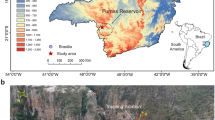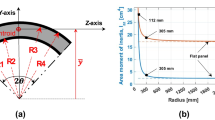Abstract
This paper is focused on developing experimentally validated models of piping components as well as a complete two story piping system. The damage in a piping system is characterized in terms of “First Leakage” based on the observations made in laboratory experiments. Monotonic and cyclic testing for pipe components of various sizes shows that the limit-state for leakage is governed predominantly by flexural deformations at the threaded and groove fit T-joints. As a first step in the validation process, the nonlinear models for the flexural behavior of T-joints are reconciled with the experimental results. Next, the validated component models are incorporated in the piping model for a two story sprinkler system. The system level piping model is then integrated with ceiling systems that interact with sprinkler heads. The complex piping ceiling system model is validated by comparison with the corresponding experimental data.
Similar content being viewed by others
References
American Society of Mechanical Engineers (ASME), (2007). Rules for construction of nuclear facility components, ASME Boiler & Pressure Vessel Code, Section III.
Antaki, G. and Guzy, D. (1998). “Seismic Testing of Grooved and Threaded Fire Protection Joints and Correlation with NFPA Seismic Design Provisions.” ASME 1998, PVP-Vol. 364, Seismic Engineering-1998, pp. 69–75
Ayers, J. Marx, (1996). Northridge Earthquake Hospital Water Damage Study, Ayers & Ezers Associates, Inc. Los Angeles, California.
Ayres, J. M. and Phillips, R. J. (1998). “Water Damage in Hospitals Resulting from the Northridge Earthquake.” ASHRAE Trans., Vol. 104, Part 1, American Society of Heating, Refrigerating and Air-Conditioning Engineers, Atlanta, Georgia.
Chang, K.H., Lee, C.H., Park, K.T., You, Y.J., Joo, B.C., and Jang, G.C. (2010). “Analysis of Residual Stress in Stainless Steel Pipe Weld Subjected to Mechanical Axial Tension Loading.” International Journal of Steel Structures, Vol 10, No 4, pp. 411–418
Chen, S. J., An, Qi, and Zhang, Yi. (2010). “Loading Analysis on the Thread Teeth in Cylindrical Pipe Thread Connection.” Journal of Pressure Vessels Technology, v. 132, p 031202.
FEMA273, (1997). NEHRP Guidelines for the Seismic Rehabilitation of Buildings. Washington, DC, October 1997.
FEMA 577, (2007). Risk Management Series Design Guide for Improving Hospital Safety in Earthquakes, Floods, and High Winds, June 2007.
Gerdeen J. C. (1979). “A critical evaluation of plastic behavior data and a united definition of plastic loads for pressure vessel components.” WRC Bull 1979; 254.
Ju, Bu-Seog, Tadinada, Sashi K, and Gupta, Abhinav. (2011). “Fragility Analysis of Threaded Tee-joint Connections in Hospital Piping Systems.” ASME 2011 Pressure Vessels and Piping Conference, Baltimore, Maryland, PVP2011-57958
Ju, B.S. and Gupta, A. (2015). “Seismic Fragility of Threaded Tee-Joint Connections in Piping Systems.” International Journal of Pressure Vessels and Piping, Vol. 132-133, pp. 106–118
Lee, J.W., Kim, S.R., and Huh, Y.C. (2014). “Pipe Crack Identification Based on the Energy Method and Committee of Neural Networks.” International Journal of Steel Structures, Vol 14, No. 2, pp. 345–354
Mazzoni, S., Mckenna, F., Scott, M. H., Fenves, G. L., and et al. (2006). “OpenSees Command Language Manual.” Open System for Earthquake Engineering Simulation (OpenSees), http://opensees.berkeley.edu/
NFPA-13, Standard for the Installation of Sprinkler System, National Fire Protection Association, 2007.
Ryu, Yonghee, Behrouzi, Anahid, Melesse, Tsega, and Matzen, C. Vernon. (2011). “Inelastic behavior of threaded piping connections: Reconciliation of experimental and analytic results.” AMSE 2011 Pressure Vessels and Piping Conference, Baltimore, Maryland, PVP2011-57949.
Structural Engineers Association of California (SEAOC). (1995). “Vision 2000, conceptual framework for performancebased seismic design. Recommended Lateral Force Requirements and Commentary.” 1996, 6th Edition. Sacramento, CA: 391–416.
Tian, Yuan, Fuchs, Jessica, Mosqueda, Gilberto, and Filiatrault, Andre. (2010). “NEESR Nonstructural: Progress Report on Tests of Tee Joint Component of Sprinkler Piping System.” Progress Report, NEESR-GC: Simulation of the Seismic Performance of Nonstructural Systems, October, 2010
Tian, Yuan, (2011). “Progress Report of Sprinkler Piping Subsystems Dynamic Test on NCS”, Progress Report, NEESR-GC: Simulation of the Seismic Performance of Nonstructural Systems, April, 2011
Wasilewski, R. J. (1998). “Seismic Restraints for piping System.” ASHRAE Transactions Part 1B, SF-98-14-1, 1273-1285.
Wittenberghe, Jeroen V., Baets, Patric D., and Waele Wim D. (2010). “Fatigue life improvement of threaded pipe couplings.” AMSE 2010 Pressure Vessels and Piping Conference, Bellevue, Washington, PVP2010-25687.
Author information
Authors and Affiliations
Corresponding author
Rights and permissions
About this article
Cite this article
Ryu, Y., Gupta, A., Jung, W. et al. A reconciliation of experimental and analytical results for piping systems. Int J Steel Struct 16, 1043–1055 (2016). https://doi.org/10.1007/s13296-016-0019-6
Received:
Accepted:
Published:
Issue Date:
DOI: https://doi.org/10.1007/s13296-016-0019-6




